
Donald Trump had initially encouraged diplomacy but grew frustrated with Iran’s refusal to negotiate, stating on June 17, 2025, that it was “very late to be talking”. By June 20, he indicated a decision on US military involvement would come within two weeks. The eminently successful US attack on Iran’s nuclear facilities on June 21, 2025 was a brilliant demonstration of what great military technology could do. It also forcefully drove the point home that the USA possessed the capability to inflict a decisive strike anywhere on the planet within hours. Several prominent X handles like @sentdefender, @visegrad24 and @AircraftSpots that monitor military movements had started reporting from the moment the six B-2 Spirit Stealth bombers had taken off from Guam airbase in the Pacific and were joined by 4 KC-135 Aerial-Refuelling Tankers each for this over 20 hour trip. The GBU-57 Bunker Buster bomb is usually dropped from a height of 50000 feet and is capable of penetrating 200 feet of earth or 59 feet of concrete. If the target is buried still deeper, we use them sequentially on the same spot.
USA’s Strategic Compulsions
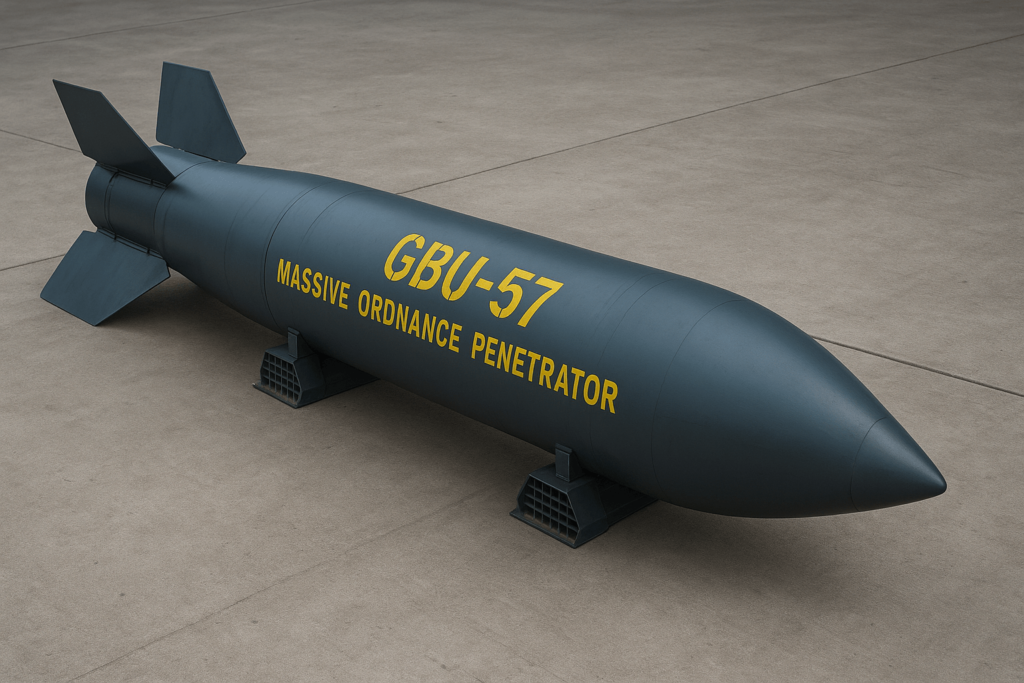
Israel lacked the capability to destroy Fordow without US assistance, as only the US possessed the GBU-57 Massive Ordnance Penetrator (MOP) and B-2 Spirit stealth bombers needed to deliver it. Israeli Ambassador Yechiel Leiter had also emphasized Fordo’s elimination as a priority, while Trump weighed the risks of direct US involvement, including potential Iranian retaliation and diplomatic fallout.
By June 17, US refuelling aircraft were tracked heading east, possibly to support B-2 bombers from Diego Garcia, indicating preparations for a potential strike. The US had previously constructed a replica of Fordow for testing the GBU-57, showing long-term planning for such an operation.
Execution of the Attack
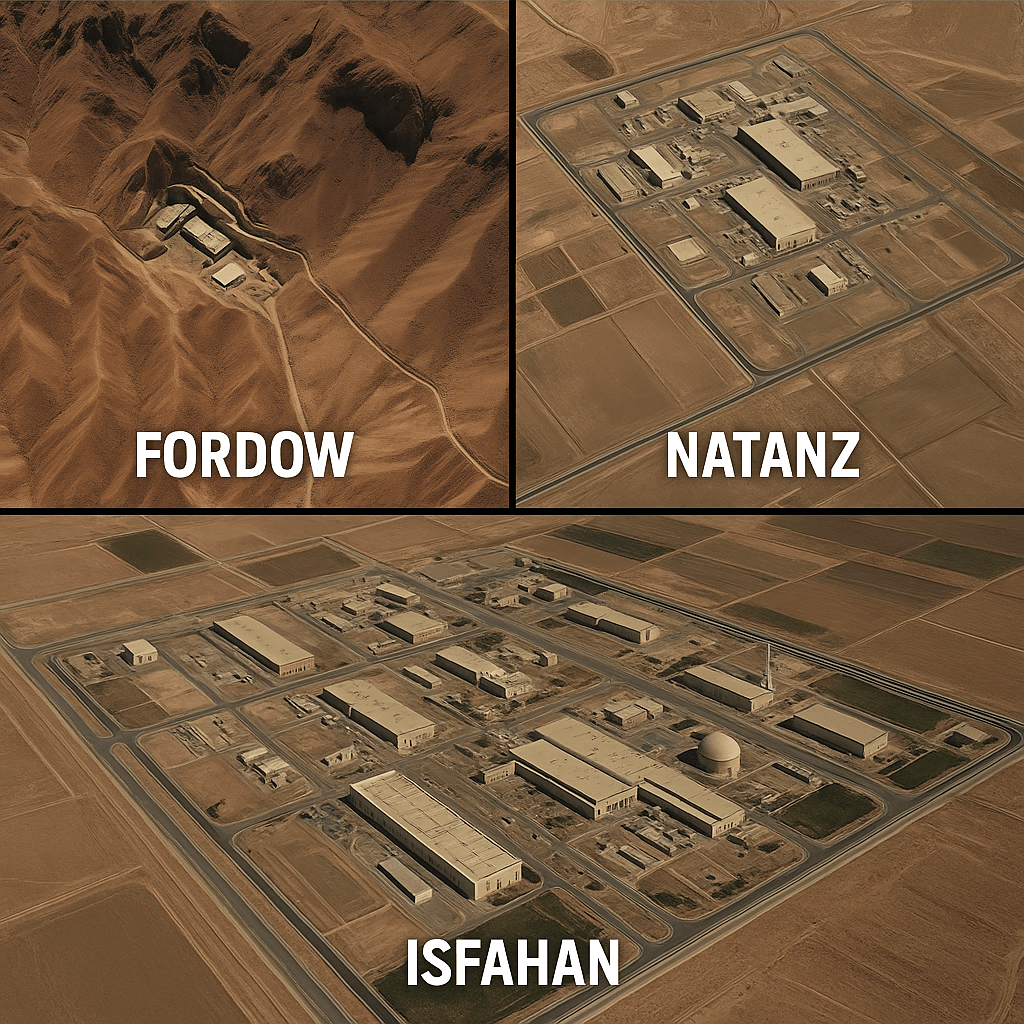
On June 21, 2025, the US launched a coordinated airstrike on Iran’s nuclear facilities at Fordow, Natanz, and Isfahan, marking the first combat use of the GBU-57 MOP. President Trump confirmed on June 22 that six GBU-57 bombs were dropped by B-2 Spirit stealth bombers on Fordow, while 30 BGM-109 Tomahawk cruise missiles targeted Natanz and Isfahan. The operation aimed to neutralize Iran’s uranium enrichment capabilities, particularly at Fordow, which was seen as the most fortified and critical site.
Target Selection: Fordo was the primary target due to its depth and role in producing highly enriched uranium. Natanz and Isfahan, with less fortified underground components, were hit to disrupt broader nuclear infrastructure.
Execution Details: B-2 bombers dropped the GBU-57s at 50,000 feet, using GPS-guided precision to target Fordow’s underground centrifuge halls. The Tomahawk missiles struck surface facilities and power supplies at Natanz and Isfahan, aiming to disable centrifuge operations. Dropping from that height gave it the tremendous velocity to penetrate the earth. In comparison, the 15,000 lbs Daisy Cutter bomb is dropped by a parachute because it is designed to clear surfaces and not penetrate deep.
Also Read: Why was it necessary for USA to destroy Iran’s nuclear plants?
GBU-57 Massive Ordnance Penetrator (MOP)
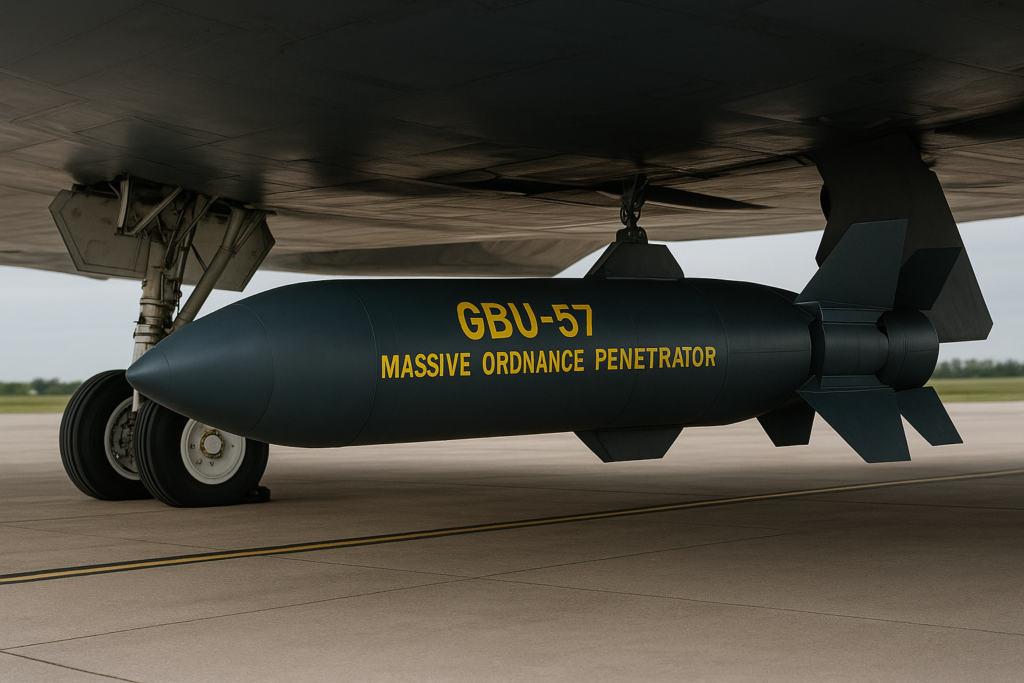
Design Specifications: The GBU-57 A/B MOP is a 30,000-pound (13,600 kg), 20.5-foot-long, 31.5-inch-diameter precision-guided bomb with a 5,300-pound explosive warhead encased in a high-strength steel alloy. Its thick casing and specialized fuse allow it to penetrate up to 200 feet of concrete or 60 meters of rock before detonating.
The alloy is called Eglin steel. It is a high-strength, low-alloy steel developed for the MOP and other bunker-busting bombs. The name “Eglin” comes from Eglin Air Force Base in Florida, where the alloy was developed. Eglin steel was designed to be a cost-effective alternative to more expensive superalloys, while still providing the necessary strength and toughness for deep penetration into hardened targets like bunkers. It’s made with a combination of elements like carbon, manganese, silicon, chromium, nickel, vanadium carbide, and tungsten carbide. This composition allows it to withstand the extreme stresses encountered during high-speed impact and deep penetration. In comparison, the first Bunker Buster, the GBU-28 was made from the spare steel barrels of 8 inch artillery.
Guidance: Utilizes GPS for high-precision targeting, enabling multiple bombs to hit the same spot sequentially, “burrowing” deeper with each strike.
Purpose: Designed to destroy deeply buried, hardened targets like bunkers and tunnels, specifically tailored for facilities like Iran’s Fordos and North Korea’s underground complexes.
Development Timeline: Initiated in 2004 by the US Air Force and Boeing to counter deeply buried nuclear facilities, with a contract awarded in 2009 for 20 units. The MOP was a response to the limitations of earlier bunker busters like the BLU-109 and GBU-28, which couldn’t penetrate Fordo’s defenses.
Purpose: To provide a non-nuclear option for destroying fortified targets without radioactive fallout, respecting the “nuclear taboo” while addressing threats from rogue states’ weapons of mass destruction.
Test History: The GBU-57 has been tested extensively but never used in combat prior to June 2025. Tests included drops from B-2 bombers at White Sands Missile Range, New Mexico, and a replica of Fordow constructed by the Pentagon in the 2010s. These tests confirmed its ability to penetrate 200 feet of concrete and navigate through rock.
Challenges: Testing revealed that multiple bombs might be needed for targets deeper than 200 feet, requiring precise sequential drops.
First Combat Use: The June 2025 strike on Fordo marked the first combat deployment, with six GBU-57s dropped to target the facility’s centrifuge halls. The bombs were intended to collapse underground structures, though it is too early to get reports about exactly how much damage was inflicted.
Comparison with Russian FOAB: Russian FOAB (Father of All Bombs) is a 15,650-pound thermobaric bomb, designed for surface detonation with a massive blast radius (300 meters) but limited penetration (less than 20 meters). Unlike the GBU-57’s precision and deep-penetration focus, the FOAB is for wide-area destruction, unsuitable for fortified underground targets like Fordo.
The US MOAB (GBU-43/B) is a 21,600-pound bomb with an 11-ton explosive yield, used in Afghanistan in 2017 against ISIS tunnels. It detonates above ground, lacking the GBU-57’s penetration capability (200 feet vs. surface blast) and is less precise. The MOAB targets softer, near-surface structures, while the MOP is tailored for hardened bunkers.
How the GBU-57 works? The Bunker Buster uses a specially developed highly ‘insensitive’ high explosive, which refuses to explode by the shock of the impact. It explodes only when triggered by its special detonator. The detonator is designed to activate only when the bomb has penetrated a certain depth. Now, how does the bomb know how much it has penetrated? That’s where physics comes in. The bomb has accelerometers which measure the deceleration of the bomb after impact. An integrator circuit integrates it to give velocity. Then another integrator circuit integrates the velocity to give distance or depth travelled. The detonator is activated only after the bomb has reached a pre-determined depth.
B-2 Spirit Stealth Bomber
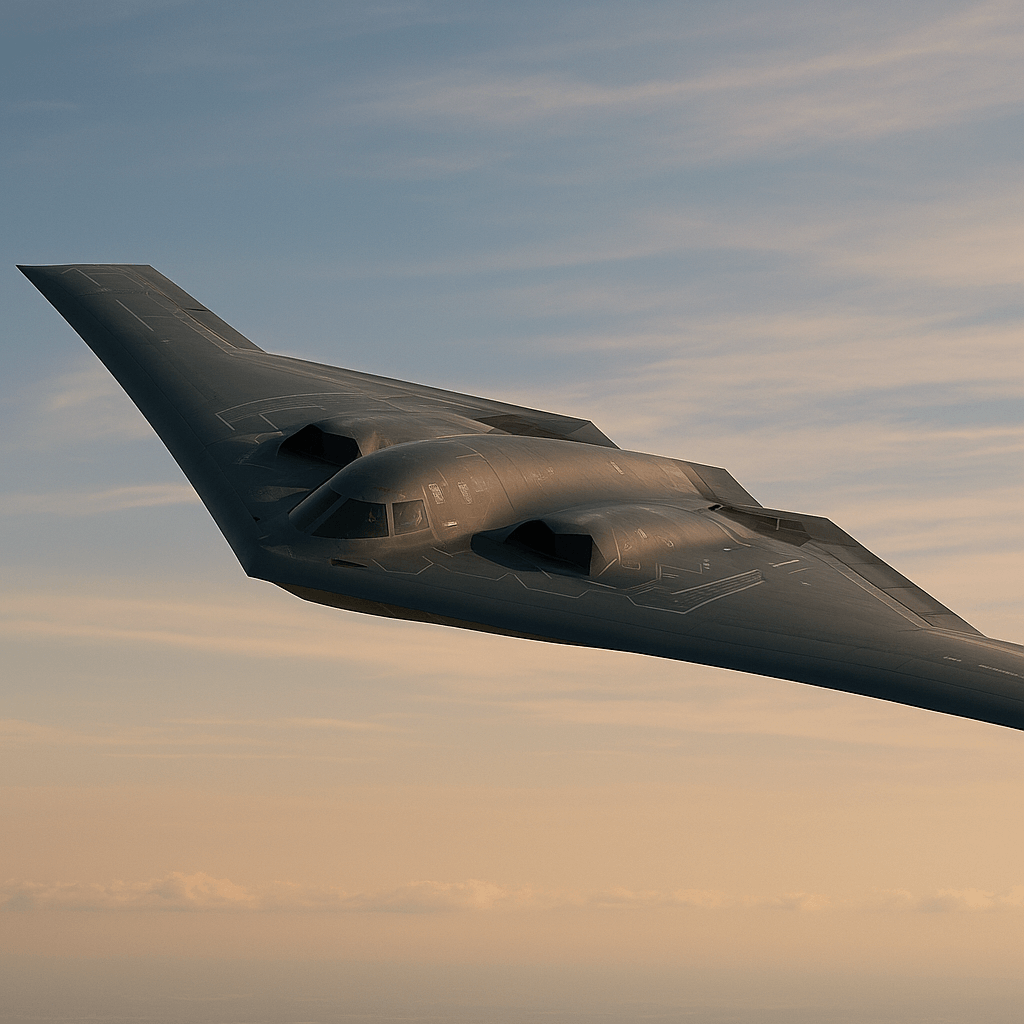
Design Specifications: The B-2 Spirit, built by Northrop Grumman, is a long-range, stealth bomber with a flying-wing design, 172-foot wingspan, and two-person crew. Though for public consumption its payload is described as 40,000 lbs, but it is well-known that it can actually carry up to 62,000 lbs in combat, that is, two GBU-57s (60,000 pounds total). Its stealth features include radar-absorbing materials and a low-observable profile, enabling penetration of advanced air defences.
Range and Capabilities: Operates at 50,000 feet with a 7,000-mile range (11,500 miles with one refuelling), allowing global reach within hours.
Development: Developed in the 1980s to counter Soviet air defenses, the B-2 entered service in 1997. Only 21 were built due to high costs ($2 billion per aircraft). It was designed for both nuclear and conventional strikes, with the GBU-57 integration completed in the 2000s.
Current Status: As of 2025, the US Air Force operates 19 B-2s, primarily based at Whiteman Air Force Base, Missouri.
Past Operations: The B-2 has seen combat in Iraq (2003), Afghanistan, Libya (2011), and against Houthi targets in Yemen (October 2024), dropping conventional bombs like JDAMs and the GBU-31. It had not previously deployed the GBU-57 in combat.
Fighter Escort: Given Israel’s reported air superiority over Iran, which neutralized most Iranian and Russian-supplied air defences (e.g., S-300PMU-2, Khordad 15), the B-2s most likely operated without fighter escorts to maximize stealth and minimize detection. Refuelling aircraft were tracked, indicating support for long-range missions. But the same tracker sites had reported that after some time into the flight, the tankers had also switched off their transponders.
Damage Assessment: Damage was assessed via satellite imagery and IAEA reports. It is still a bit too early to get exact reports. Nobody is saying that the bombs missed their target and hit somewhere else. Nobody is showing a wasted crater somewhere else. I cannot teach physics in an article but try to understand it this way. The Bunker Buster bomb is very narrow—just 31.5 inches wide and 20.5 feet long. It actually penetrates the earth like a nail. It DOES NOT explode on the surface. Would you easily see a 2.5 feet diameter hole from a satellite? You see, the nail goes deep inside the earth—some 200 feet of concrete or 60 feet of solid rock before it explodes. Yes, it will create a cavity alright by its explosion, but it will be immediately filled by the debris falling back into it from all sides. Hence, viewed from the top, you are not likely to find a huge crater. It is that debris, which would trap most of the radiation possibly trying to leak out.
It is therefore quite possible that no radiation leak is detected yet because of the sheer depth of the facility and the debris having jammed the hole made by penetration of the bomb. However, as a nuclear physicist, I can tell you that even if there is spillage of radioactive material and consequent radiation leak, Iran will have no option but to contain it by a Chernobyl-style concrete entombment. That’s the price they have to pay for their audacity.
Why the B-2 only? Perhaps you might wonder why the USA did not use its other great bombers like the B-52 Stratofortress and the B-1B Lancer? In simplest words, the answer is two-fold. First, they are not stealth bombers. It would have been necessary to send a heavy fighter escort. Second, their bomb-bays are not configured to carry such a huge bomb, even as their individual payloads or bomb carrying capacity is higher. The GBU-57 had to be carried in the internal bomb-bay for stealth. Slinging it outside (as the intrepid Soviets had done with the Tsar Bomba on a Tu-95 bomber, cutting its belly open) would have been impractical for the B-52 and the B-1B.
The Strategic Impact
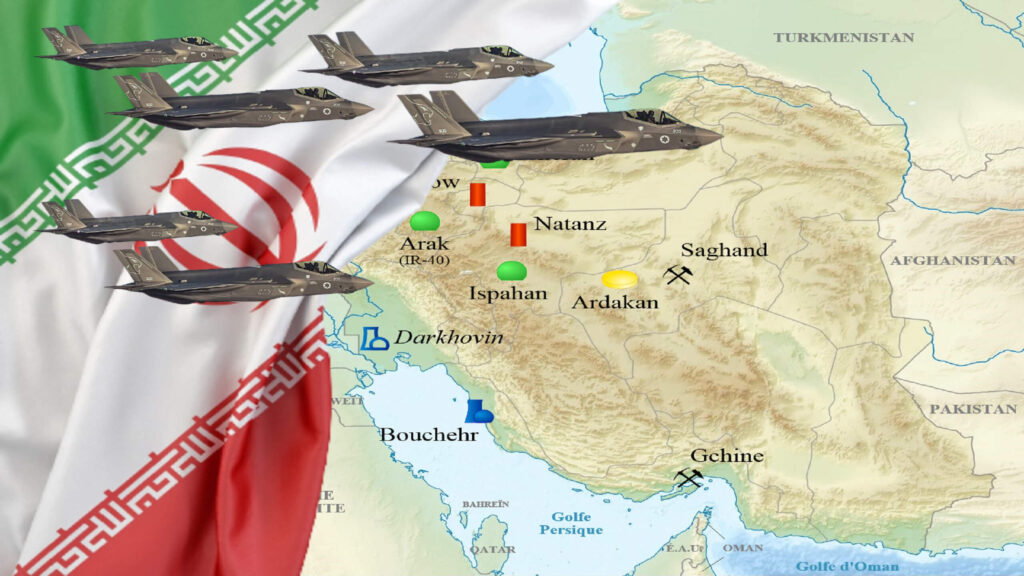
The strikes might not have directly threatened the Islamic Republic’s survival, but they have caused a “profound psychological effect” and exposed vulnerabilities. Israel’s stated goal includes regime change, but US objectives appear focused on nuclear disruption. Iran’s pride is gone; it is not punctured but literally busted.
Regime change might be unlikely in the short term due to Iran’s entrenched theocratic system and security apparatus. However, sustained military pressure, economic collapse, and internal dissent would weaken the regime over time.
Russia would view the US strike as a challenge to its regional influence. But, it must be kept in mind that they had lost the strategic game in Syria also. Trump’s intrinsic boldness to take risks and his absolute disregard of world opinion ensured that his move paid off gloriously. Russia may condemn the attack as an act of aggression, but direct military retaliation is unlikely due to Russia’s focus on Ukraine and economic constraints. Russia could respond by increasing arms supplies to Iran or proxies, though no specific reactions were reported as of June 22, 2025.
China, a major buyer of Iranian oil, is likely to criticize the US for escalating tensions and disrupting energy markets, as the strikes caused oil prices to surge. China may push for diplomatic de-escalation via the UN, but its limited military presence in the Middle East makes direct intervention improbable. Economic support to Iran, such as increased oil purchases, is a possible response.
The very fact that the US military knew that the whole world knew and was monitoring that the B-2s were on their way, and yet they went ahead with their attack with these extremely costly aircrafts ($2.1 billion each) without fighter escorts, shows the tremendous confidence they have in their weapon systems and their pilots’ abilities.

